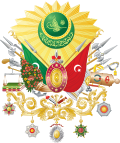This article needs additional citations for verification .(July 2023) |
| Deli | |
|---|---|
 A Deli (left) in a battle with a Hungarian soldier | |
| Active | Mid. 15th century - 1829 |
| Allegiance | |
| Type | Light cavalry |
| Role | Shock troops |
| Garrison/HQ | Rumeli Anatolia |
| Military of the Ottoman Empire |
|---|
 |
Deli (from Turkish deli, meaning "mad, wild, daring") [1] were a Turkish light cavalry unit within the Ottoman Empire. Their main role was to act as front-line shock troops, also acting as personal guards for high-level Ottoman officials in the Rumeli during peacetime.








